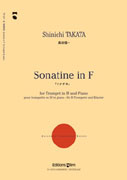Takata, Shinichi Sonatine in F
Trumpet Solos w/Piano

-
Takata, Shinichi
Sonatine in F
20th Century (1937). Shinichi Takata's Sonatine in F major is the earliest piece of original trumpet music ever written by a Japanese composer. The existence of this music has only recently been acknlowedged, and among the reasons for its previously unknown status are the facts Takata was, by reputation, primarily a conductor rather than a composer, and, further, because he died at the early age of 39. Furthermore, this score must have been very difficult, if not impossible, for any Japanese trumpetplayer to play at the time it was written; indeed, it was never performed until my recording. In 1999, this piece was introduced to the world for the first time after it had been found among the mementos of Professor Fujio Nakayama, the acknowledged founder of the Japanese trumpet school. Shinichi Takata wrote the Sonatine F-dur in 1937 when he was 16 years old, and it is dedicated to Fujio Nakayama, his class mate in the Tokyo Music School. Shinichi Takata was a prominent pianist who also played the oboe. Consequently, his score requires quite a high level of technique compared to the other trumpet music of its time sensitivity.Written during the 1930's, when much of the significant solo trumpet music was composed, the musical content of Sonatine F-major is, in a general context, somewhat akin to the works of Karl Pilss (1935) and Paul Hindemith (1939). Takata's work, however, written when he was only 16 years old, is different from these other works in that it exhibits the added strong influence of French Impressionism together with his gifted Japanese sensitivities.
In the first movement, there is an exposition section which presents two graceful motives that are dynamically developed with distinctive rhythms that are ultimately resolved in a well-defined tutti. In the second movement, the music begins with an elegiac fanfare followed by a march heard over a solemn piano accompaniment. The fanfare then returns to bring the march to an end with a distinctive Debussy-like piano chord. The music then proceeds attacca to the third movement, which features some very impressive French sounds and a feel of syncopation that seems rooted in the jazz idiom of the time.
As the last pupil of Professor Fujio Nakayama, it is my great pleasure and honor to introduce this work. -Osamu Kumashiro -
- Category: Trumpet Solos w/Piano
- Item: 063321
- Grade/Level:
- Price: $36.95
-
(usually ships in 10 to 15 days)
